New iGem team gets started
The 2021 iGEM team has just been recruited! Dr Dominic Glover commented that this year’s team includes a number of students from BABS as well as Design, Marketing, and Ecology.
The 2021 iGEM team has just been recruited! Dr Dominic Glover commented that this year’s team includes a number of students from BABS as well as Design, Marketing, and Ecology.

iGem (the International Genetically Engineered Machine Competition) is an annual international competition that gives students the opportunity to push the boundaries of synthetic biology by tackling everyday issues facing the world. Multidisciplinary teams of undergraduate students work together to design, build, and test a biological system of their own design using interchangeable biological pars and molecular biology techniques. Every year over 300 teams from more than 40 countries come together in October to present their research and compete at the annual iGEM Jamboree.
In 2020, the UNSW Team was awarded a gold medal and several major prizes for their project that aimed to prevent bleaching of coral hosts by engineering thermo-tolerant microalgal symbionts. Their project PROTECC CORAL (Prevent Reactive Oxygen and Thermal Extreme Caused CARKING) utilised synthetic biology approaches as well as an understanding of the human practices to reach responsible solutions to coral bleaching on the Great Barrier Reef.
The team of sixteen students all shared a connection with the significance of the Great Barrier Reef, and their passion to combine conservation and synthetic biology to solve the problems facing the health of the reefs. Bella Beach, a member of the 2020 team provided her insights into the competition, 'iGEM provided a glimpse into real-world science from the seat of an undergrad student. It was a chance to meet and collaborate with like-minded students from within UNSW, as well as those from schools across the globe. It was a life-changing experience, and will no doubt form the foundations of the rest of my science career.'
Students also embraced the value of science communication in increasing awareness of such big environmental challenges, and produced a children's book (Captain Coral to the Rescue!), an education package and even a virtual escape room game! The 2021 iGEM team will continue the project to engineer microalgal symbionts, with reduced COVID-19 restrictions enabling the designs to be tested in the laboratory.
Written by Dr Lisa Selbie and Dr Dominic Glover